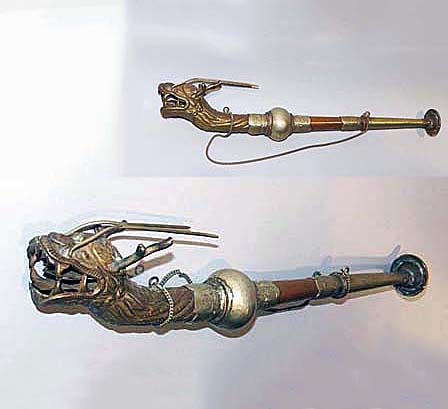
Owner: HWMC
Catalog#: AS-AELV-05-14
Lip Vibrated
Nepal ‘Hiti Manga’ (Trumpet)
Nepal and Eastern India
Nepalese – Indian
Metal
Mid 20th century
Length: 20 in, Width: 4 in
Aerophones – Wind Instruments Proper – Lip Vibrated
The hiti manga (chu-srin) is a Bhotiyas (Tibetan Buddhists in Nepal) copper bugle that shares the name of a mythical creature. It is decorated with a Tibetan Chu-srin or Makara (a legendary mythical sea-creature) and depicts the monster’s open mouth with a distinct upward pointing snout serving as the bell of the trumpet. It is played by buzzing the lips in a circular lipped mouthpiece. The hiti manga is played in rituals connected with the deities, often used to signal the entry of dancers in ritual ballets.
According to the Metropolitian Museum [https://www.metmuseum.org/art/collection/search/505280]:
The thighbone of a lama priest is the original form of these metal trumpets in this case. A single rkang-gling (‘leg bone flute’) is used with a pellet drum to escape epidemics. Pairs signal the entry of ritual dancers, and perform rituals connected with fierce deities. The head of a chu-srin (Sanskrit: makara), a sea monster or a dragon, often provides a decorative metalwork bell. When the rkang-gling is made of metal, bosses decorated with trefoils cover the joints where the sections of cooper and/or silver tube are joined. The trefoil, a three cusped design, is an emblem of power and authority and is used as the head of a scepter. The chu-srin and dragon are associated with water and rain and may decorate the rkang-gling.
